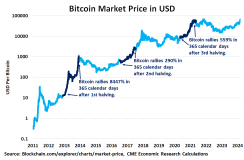Scott Bauer, for CME Group
AT A GLANCE
- The production of bitcoin is capped at 21 million, and over 19 million bitcoins have already been mined
- As the next halving approaches, CME Group Micro Bitcoin futures volume increased to record highs of nearly 136,000 contracts in early March
Bitcoin finally broke its previous all-time high record and has been on an incredible run this year. It is up over 50% in the past two months, and more than $6 billion has entered the crypto market since spot bitcoin ETFs began trading earlier this year. The upcoming halving has the potential to push bitcoin prices even higher.
Approximately every four years the total number of bitcoin that miners can potentially harvest is halved. This is a technical event that happens after every 210,000 blocks are added to the blockchain. Halving was written into bitcoin’s code to ensure scarcity and to protect from inflation. This means that new production of bitcoin generates 50% of the yield it used to. The fourth halving is around the corner, scheduled to take place in April.
Supply of Bitcoin Continues to Decrease
Central banks, like the Federal Reserve, have tools at its disposal which enable it to control the amount of currency in circulation. When an economy is sluggish or stagnant, the Fed or other central banks can increase circulation by purchasing securities from banks. As we have seen for the last couple of years, the Fed has sold securities from its account to remove dollars from the economy.
When bitcoin was created, its code capped it at a fixed amount – only 21 million bitcoins can ever be produced. Over 19 million have already been mined meaning that the supply of bitcoin is getting smaller. While the number of new bitcoin entering circulation keeps shrinking, demand should, in theory, stay the same.
Price Volatility After Past Halvings
Previous halvings have resulted in sharp price increases and extreme volatility for bitcoin and other cryptocurrencies. In 2012 around the first bitcoin halving, the price increased by 80 times. The 2016 halving preceded a 300% rise in its value, and in the 16 months following the 2020 halving the price of bitcoin rose more than 600%.

The interest isn't only in spot Bitcoin ETFs, as CME Group Bitcoin products continue to experience growth.
Average daily volume (ADV) and open interest in CME Group Bitcoin futures and options, which set records in 2023, keeps increasing. The popularity is evident as CME Group added Bitcoin and Micro Bitcoin (MBT) weekly options to its suite of products. In 2024, ADV in Micro Bitcoin futures has risen to approximately 28,000 contracts, with a new record volume day on March 5 at nearly 136,000 contracts traded. Open interest, or the number of unsettled contracts, in Bitcoin futures set records for 11 consecutive trading days later in March.
Halving plays an integral role in maintaining Bitcoin’s most important characteristic – its scarcity. Despite miners receiving fewer rewards at each halving, this scarcity could continue to make Bitcoin intriguing for investors into the future. The global economic landscape is changing quickly and cryptocurrencies like Bitcoin are potential safeguards against economic instability of traditional markets.






